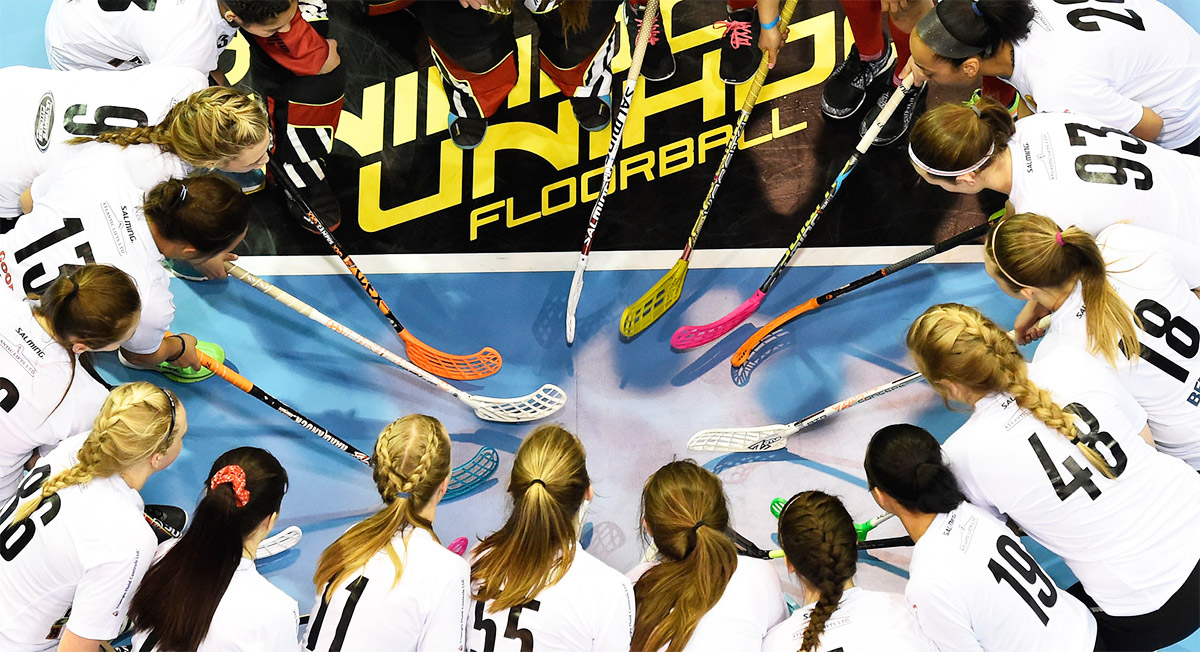It might not be rocket science, but sometimes it’s close to that. Picking the right floorball stick can become a demanding challenge. Luckily you gut us to show you the way.
___STEADY_PAYWALL___
1. Length
The golden rule to pick a stick that goes up to your navel is a practical advice for beginners. However, if you’re a defender, you come from ice-hockey or you just want to have a bigger reach, you can add some centimeters. But the longer a stick the worse your ball control. So if you want to focus more on your technique, the stick should be rather shorter. Nowadays brands communicate two stick lengths, such as 96/197 or 103/114. The first value describes the length of the shaft without the blade, the second the length of the whole stick (in a lean of 60° to the floor).
2. Weight
Sticks are getting lighter and lighter. A low stick weight might improve your ball control, but the missing mass will reduce the power you release the ball with. If your game relies on perfect ball handling, consider a lower weight. The lightest high-end sticks don’t carry more than 200 g (in shaft length 96 cm), some go even bellow 190 or 180. Also good to know, lighter sticks usually break easier and technology sticks can be a bit heavier (220 to 250 g).
3. Balance
In tennis or squash brands define the balance point of their rackets. And there’s a good reason for that. Even though you prefer very light floorball sticks, you’ll find out, that the right balance can be even more important than that. A nose-heavy stick can feel heavier than a grip-heavy stick. Grab that stick and a ball and just give it a shot, literally. You’ll have to listen to your feel.
4. Flex
Actually, the material of a shaft (lighter but more expensive carbon or a heavier but cheaper composite / glassfiber compound) is less important to your game than its flex. This value defines the stiffness of your stick. The softer it is, the more feel you’ll have for your ball (at least to a value around 30 or 32 mm). But unfortunately you’ll lack power. In general kids should find a flex between 30 and 36 mm, juniors and women one between 27 and 32 mm, men one between 23 and 27.
5. Shaft Form
Players who come from a different hockey discipline or who like to put a lot of power in their sticks often prefer oval (or even cubical) shafts. This is a question of taste. But remember that round shafts are a bit more flexible while being moved, oval shafts fit better to your palm. In case of need, there are simple inlays you can put bellow a grip to make an oval shaft out of every round shaft.
6. Thickness
Some players prefer thicker, some prefer thinner grips. Thicker grips allow you to put more power in your shots and passes, thinner grips provide you with more feel. Usually thinner grips, as there is less material between your hand and the shaft, get battered faster.
7. Grip Surface
The surface of grips doesn’t differ that much, as it’s the goal of every brand to produce a proper rubber material. Try to keep the grip grippy and don’t wait too long before you change it for a new one. A slippy grip can demolish your whole technique. Be aware that most brands put their thinnest grips on their series sticks. You might want to change it soon anyways.
8. Blade Material
Most blades are being made of fusion plastic compounds that differ in their torsion and in their stiffness. Some blades glue more to the floor than others. This might be a good thing for passes and ball control but in general you might prefer a slippier blade. More important is its stiffness. The stiffer a blade the harder the shots and… the worse you ball control. Beginners and more technique-oriented players prefer softer blades, players who look for strong distance shots go for harder blades. Tip: Try to avoid extreme temperatures, as heat makes your blade softer, cold harder and more fragile.
9. Blade Form
This is a very individual one. Of course you can put every blade in boiling water and adjust it (before hardening it in the freezer again). But the brands create their blade models always with special features. A more concave blade will help you to control the ball with your forehand and it will support your sweeper shots. Unfortunately it will also reduce your general ball control (as your backhand suffers) and you’ll have to hit your slap shots with maximal precision to keep them accurate. On the opposite straight blades support your ball handling and they are more versatile in anything you want from them (even adjusting them in boiling water).
10. Technologies
Brands usually develop their high-end carbon sticks with special technologies. They curve and they bow them, put little kinks in its shafts or they work with some stiffening elements. Each technology has it’s own purpose. Most of them are engineered to improve your shot. But keep in mind that the more modifications a straight shaft gets the less information about your blade hitting the ball reaches your hands. This can have negative effects on your overall ball control.
Now you know how to pick your floorball stick, innebandyklubba, florbalku, Floorballschläger or salibandymaila. If you want to know how to treat it, too, read our article „11 Things Not To Do With Your Floorball Stick„.

